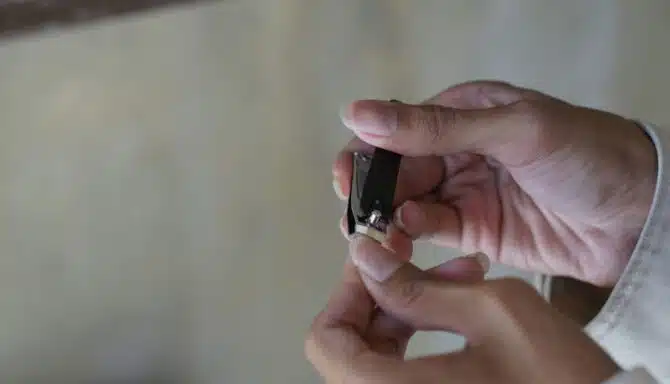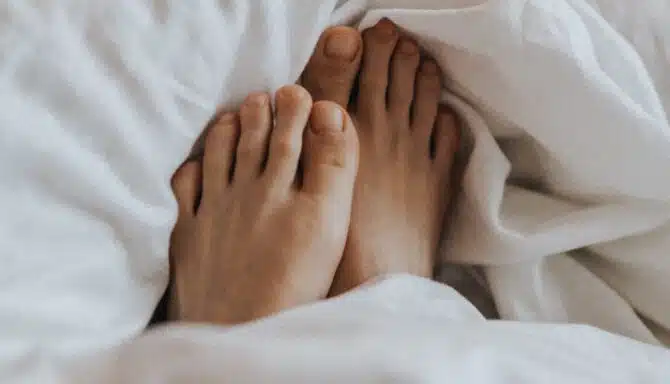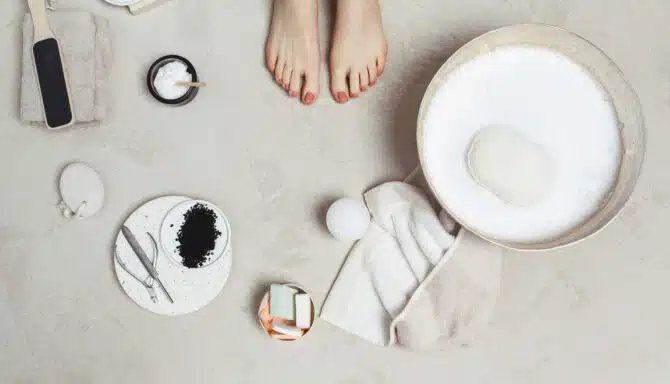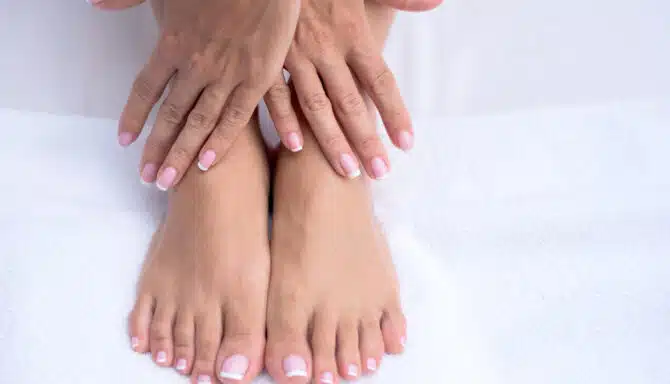July 11, 2024
There's always the right tool for the job. Using each tool for its intended purpose is best, or you risk doing more damage than good. That's why fingernail clippers and toenail clippers exist.
To understand why, it's important to understand the difference between toenails and fingernails. Toenails are thicker, harder, and grow slower than fingernails because your feet and hands serve different functions. Toenails also have a greater surface area.
In this blog post, we explain why you should avoid using fingernail clippers for your toenails and opt for toenail clippers exclusively.
Reduce the risk of bacterial or fungal contamination
For one, separating your nail tools prevents contamination and possible spread of bacteria and fungus. Given how exposed your hands are every day, you wouldn't want to spread any bacteria to your feet.
When in doubt, clean your clippers with 70%—90% isopropyl alcohol.
Fingernail clippers may not work on toenails
When looking at fingernail vs. toenail clippers, the size difference is stark. Fingernail clippers are smaller, narrower, and curved. Toenail clippers are larger, wider, and straight across, as you should trim your toenails straight across. Cutting them with a curved edge increases your risk of ingrown toenails.
If you want more guidance on choosing the tool for your toenails, read our blog post on our top choices for toenail clippers.
Limit the risk of cracking and damaging your toenails
Using sharp, rigid toenail clippers makes trimming easy and more effective. Using fingernail clippers means you'll need to apply more pressure to cut the nail and risk damaging or even cracking the toenail.
If you don’t have the right tools, enough time, or simply the confidence to focus on a nail trim, try a medical pedicure instead. It includes the right nail trimming procedure and includes moisturization, thorough cleaning, and more. Before the nail trim, a chiropodist also examines your feet for other foot conditions.
Prevent ingrown toenails
You'll also notice the curvature of fingernail vs. toenail clippers. Fingernail clippers are curved and meant to follow the contours of your fingernails. On the other hand, toenails are plateaued and should be cut straight across. Using a curved tool on your toenails puts you at risk of jagged edges, nail splitting, or could be a root cause of ingrown toenails.
If you wish, use a nail file to round the edges. This tool is necessary for properly smoothing the edges of the nails. After the trimming, there will likely be some jagged edges, sharp corners, and “spikes.”
July 4, 2024
A toenail falling off can be uncomfortable and cause concern about damage to the toenail. The goal is to preserve the toenail's state to prevent further damage.
Fortunately, if you take a few proactive steps, you can reduce the discomfort and promote healing. Here are our six tips for managing a toenail on the verge of falling off.
1. Keep the toenail area clean and dry
Wash the toenail gently and often. We recommend using mild soap and water to keep it clean. Next, pat dry so as not to snag the toenail with a towel.
2. Cut the nail carefully and slowly
Use clean, sterilized nail clippers to remove any dangling or loose portions of the toenail. Cut straight across without digging into the surrounding skin. The goal here is to prevent further snagging or tearing down the road. Improperly cutting your nail may also increase your risk of an ingrown toenail.
In addition to trimming the toenail straight across, you should trim the toenail slowly. Don't over-cut it. Be patient with toenail growth. (It may take months to a year for a nail to fully grow out.) If in doubt, let our toenail specialists in Toronto trim your toenails for you as part of a medical pedicure.
3. Use a non-stick bandage to protect the area
We recommend applying a bandage or non-sticky wrap to your toe. (Adhesive can attach itself to the toenail and be difficult to peel off without grabbing onto it.) A protective layer keeps an otherwise exposed nail bed safe. Replace the bandage regularly and keep the area dry to promote healing.
4. Antiseptic ointment is your friend
Use an antiseptic ointment or petroleum jelly on the exposed nail bed to keep it moisturized and prevent infection. This may help soothe any discomfort from the loose toenail.
5. Choose comfortable and roomier footwear
You'll want to reduce pressure as much as possible to prevent a loose toenail from falling off. Given that we wear footwear so often, finding shoes with ample fit can help prevent further damage to the toenails.
6. Avoid intense activity
Reduce your activity level if it puts excessive pressure or strain on the affected toenail. For instance, running or high-impact sports like soccer could increase the risk of the toenail getting snagged or torn off. Give your toe some rest, and return to physical activity gradually.
June 20, 2024
At first glance, our toenails look like a single nail, and that's about it. However, beneath the surface is a more complex structure that makes up the nail and the bed below it. This is our toenail anatomy.
Toenails and fingernails are made of Keratin. Keratin is a type of protein that gives the nail strength and protection. (There are many types of Keratin. It also comprises hair and your epidermis.) Toenails differ from fingernails in a few ways, namely their thickness and growth rate, as the external forces on your toenails are greater than those on your hands.
Today, we explore toenail anatomy and how each component affects foot health.
Layers of the toenail
Nail plate
The nail plate is the easiest part of the toenail anatomy to recognize. It's the nail itself. The colour and texture of the nail plate can vary based on factors like health, genetics, and lifestyle habits.
Nail bed
Next, we go a bit deeper. The nail bed is beneath the nail plate. Just like sheets and blankets are the nail plate, imagine the nail bed is the mattress or bed frame below. The nail bed is a layer of skin that nourishes the nail as it contains blood vessels and nerves. It is also the growth engine behind the nail plate.
If you damage the nail bed, you'll notice nail plate abnormalities or reduced growth rates. Sometimes, a damaged nail bed will cause you to lose a toenail or experience a discoloured toenail. A subungual hematoma occurs within the nail bed and can cause a black toenail.
Lunula
The lunula, or "half-moon," is the pale, crescent-shaped area visible at the base of the nail. It represents the edge of the nail matrix, where new nail cells are generated. Eventually, nail growth from the lunula extends out to the outer edges of the nail, at which point you'd trim them.
Nail matrix
The nail matrix is the tissue beneath the cuticle at the base of the nail. It produces new nail cells, pushing older cells forward and resulting in nail growth. Damage to the nail matrix can affect the quality and growth rate of the toenail. Each nail matrix produces 196 layers of cells that combine to make your toenails.
May 13, 2024
Summer foot care and pedicures - can you name a more iconic duo? Showing off a sleek pedi is one of the best ways to enjoy the warm months. But safe pedicures differ greatly from your run-of-the-mill cosmetic pedicure, so it’s important to be on the lookout for the safest way of avoiding pedicure infections. We’ve got 3 pedicure safety tips you should follow before you hit the salon!
Top 3 Pedicure Safety Tips
Choose clean salons or foot clinics
Avoid certain tools
Practice aftercare
Choose Clean Salons or Foot Clinics
Only visit nail salons that demonstrate good practices. Be on the lookout for:
An organized workspace.
Equipment sanitization protocols. An autoclave with steam sterilization is best.
Employees visibly maintaining hygienic standards.
Employees using disposable liners in the foot baths, and cleaning and filtering them between uses.
Fresh linens (if applicable).
Clean floors and surfaces.
Clean uniforms on employees.
Clear labels on products.
Clients wearing protective footwear when walking around.
Another good tip is visiting your nail salon when they first open in the morning, when everything is cleanest!
Pedicures at Feet First Clinic
Foot clinics are where you can get a medical pedicure, which tends to be safer than a cosmetic pedicure.
Appointments don’t happen in communal areas, unlike salons, so you’re already in a safer environment with less people spreading contagious fungal infections. And although you’ll be skipping the polish (you can always apply it yourself afterwards!) and foot bath (again, you can do this at home - foot baths at nail salons are not hygienic, especially if the bath has jets), you’ll be enjoying so much more than you can get from many salons. This includes:
Guaranteed use of sterilized, safe tools.
A thorough cleaning of the entire foot with alcohol.
An inspection of your feet from a chiropodist who can recognize foot conditions.
Thorough cleaning of dead skin(onychophosis) under the nails.
Callus softening or removal.
Learn more about what happens during a medical pedicure and the differences between a cosmetic vs. a medical pedicure.
Avoid Certain Tools
Nail technicians in salons use many tools, but you should kindly request they skip some of them. One of these is the foot rasp or “grater” they use to scrape the bottom of the feet. It can be overly abrasive and damage the skin, leading to irritation and cuts. Strong skin is a barrier for contaminants, and damaged skin welcomes dirt and infections.
To protect your feet even more, you can skip tools that don’t appear to be properly sanitized or cleaned between uses, or avoid tools with visible signs of wear and tear.
Practice Aftercare
After getting your pedicure, it’s up to you to keep on top of proper foot care! Here’s what to do:
Avoid tight shoes that crowd the toes. This can cause ingrown toenails.
Wash your feet every day with gentle soap before thoroughly drying.
If you must cut your own toenails, only trim straight across, avoiding shaping.
Moisturize and exfoliate your feet.
Wear clean cotton socks and change them frequently.
March 18, 2024
Toenail care is your shield from future foot issues. Foot conditions affecting the toenails can lead to infections, fungus, brittle and damaged nails, pain, bleeding and more. But you have the power to prevent these complications! By investing in proper footwear, learning to trim your nails properly, and more, you can take the reins on your toenail health.
Let's talk toenails!
Preventing Fungal Infections and Other Toenail Conditions
Practice Proper Toenail Trimming
It would be nice to have a professional always trim our nails for us, but sometimes we do have to do toenail care ourselves. To prevent issues or conditions, trim your nails following these two simple steps:
Use nail clippers to trim straight across (very important), avoiding curved edges.
Smooth edges with a nail file if needed.
Keep Your Feet Clean and Protected
Fungal toenails love when you forget to care for your feet.
Make sure you always thoroughly clean and dry your feet before wearing socks and shoes. To go the extra mile and protect from skin issues, moisturize, exfoliate and use a foot file.
Avoid areas where contagious fungal viruses breed and are passed along. These include public pool grounds, public showers, shared locker rooms, and more. If you frequent places like this, always wear shoes.
Pedicure safety and hygiene are also very important when it comes to prevention. Schedule medical pedicure appointments with your chiropodist instead of a cosmetic pedicure to avoid contracting a contagious fungal infection and for a more health-focused experience. Learn more about the difference between a cosmetic and medical pedicure.
Make Healthy Footwear Choices
The link connecting toenail issues and footwear may seem unclear, but picture it this way:
When our shoes are too tight it often means there is not enough room for the toes to spread out naturally. This can wreak havoc on your nails and you also risk annoying ingrown toenails or a cracked toenail. Always buy shoes with enough room in the toe box!
Take it to the next level by looking for running shoes with mesh uppers that allow air to flow inside the shoe. This is a bonus way of keeping your toes fresh and protecting against fungal infections. Check out this handy shoe shopping checklist for even more help!
Toenail Care for Pre-existing Conditions
Anti-fungal Treatments for Toenails
You won’t be able to treat a current fungal infection without using antifungal products or visiting a chiropodist. Products include sprays, ointments and sometimes pills. At times, over-the-counter versions like ClearNails Pro + (available at Feet First Clinic) are enough, but other times, you’ll need a prescription for a persistent infection. Chiropodists can also perform nail debridement, which involves removing the infected part of the nail and thinning the outer layers of the toenail. This allows prescription-strength topical antifungal medication to penetrate the toenail and reach the fungus.
Treating Cracked Toenails
Cracked toenails are more of a nuisance than a serious problem. But messing with your toenails in any way can still cause bleeding and pain. You may be more susceptible to cracks if your nails are weak and brittle.
If you’re looking for some ways to speed up nail growth, but also to strengthen your nails as they are, try these toenail growth tips:
As we've mentioned, trim nails straight across and avoid trimming too close to the skin
Again, wear well-fitting shoes. Tight shoes can disrupt healthy toenail growth.
Protect toenails during physical activities.
Avoid excessive use of nail polish. While polish itself doesn’t slow growth, some types can cause toenail dehydration, making your nails more likely to crack.
Eat a balanced diet for nail health.
Treating Ingrown Toenails
OnyFix is a useful and modern way of treating ingrown toenails. It involves the application of a specialized corrective strip to the affected nail. Nail avulsions can also be a good idea for chronic, severe ingrown nails, and chiropodists may tackle infections using certain draining methods.
Treating Toenail Discolouration
Discoloured toenails are tricky because the colours can vary wildly. Discolouration caused by a fungal infection (green or yellow) may be treated using similar methods as fungal toenails. But if your discolouration is black, blue, purple, or red, this is probably linked to a mild blunt-force trauma injury (like dropping something on your toe). It’s best to schedule a nail care appointment to determine the culprit!
December 11, 2023
The words “pedicure” and “treatment” may seem like a strange combination. But when you’re talking about medical pedicures, the perception changes. When it comes to treating foot conditions, the effectiveness of medical pedicures is clear, and they’re drastically different from cosmetic pedicures. Not only can they help manage skin and toenail conditions, but they shine as a preventative measure against future issues.
Medical Pedicures: Prevention and Treating Foot Conditions
While medical pedicures make your feet look amazing, the real benefit of a medical pedicure is foot health. The nails are properly cleaned and trimmed, and your chiropodist also smoothens calluses, moisturizes and cleans your feet, cleans your cuticles and keenly inspects your feet for abnormalities that can signal a problem. The latter is extremely helpful for people with diabetic neuropathy, who need an extra set of eyes and expertise to treat minor problems before they become critical (ulceration, gangrene, etc).
Medical pedicures also treat the following skin conditions:
Calluses and corns
Cracked heels
Blisters
Athlete’s foot
And of course, toenail conditions:
Ingrown toenails
Cracked toenails
Discoloured toenails
Fungal / thick toenails
Please note, if you have a severe toenail infection, you may need to use medicinal ointments or take oral medications before getting a medical pedicure.
Medical Pedicure Effectiveness Against Skin Conditions
Chiropodists use medical-grade equipment during medical pedicures to remove dead skin on the feet, which can often become painful when left ignored and ultimately turn into large calluses. Chiropodists may also gently buff down or completely remove pre-existing calluses and corns during medical pedicures.
Furthermore, the thorough moisturizing session that occurs during a medical pedicure can fight dry skin, especially during the winter months. Dry skin can lead to painful cracked heels. In some cases, dry skin also poses an ulcer risk. Moisturized feet are also less prone to blisters.
Image source: iStock
Medical Pedicure Effectiveness Against Toenail Conditions
When it comes to ingrown toenails, chiropodists carefully trim the affected nail during a medical pedicure, ensuring it is properly shaped to prevent further irritation and discomfort. They will clean the area to reduce the risk of infection, and safely remove jagged edges from cracked toenails so they can regrow properly.
While you may need medicine to treat a fungal toenail infection, medical pedicures can be useful as well. Chiropodists can carefully reduce the thickness caused by the fungal infection, clean the nail and surrounding area, and provide additional guidance on how to wipe out the infection.
Image source: iStock






